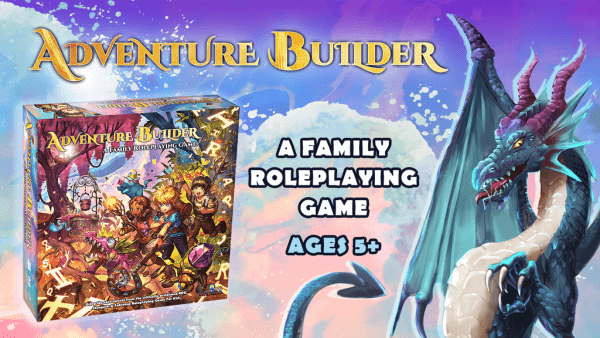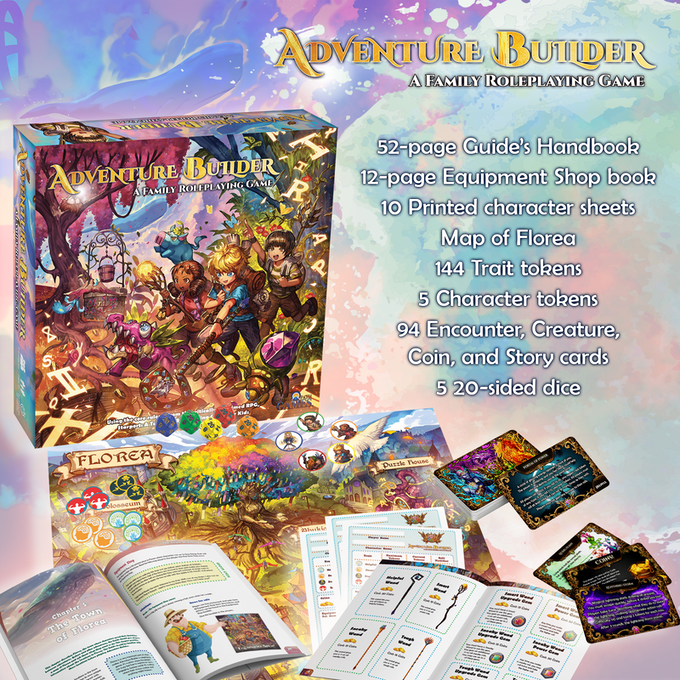Preview: Adventure Builder Is a Kid-Focused Fantasy Role Playing Game

From furry giants to spark dragons, work together to find creative solutions to the many problems your guide sets up for you!
Currently on Kickstarter, Adventure Builder is a rules-light RPG designed for families and kids, with a focus on non-violent solutions and cooperative storytelling.
Gameplay
One person will be the guide and the others will be the players. Each player creates a character. Character creation is simple: you take a character token that shows a picture of your adventurer and you take a character sheet. On your sheet you write down a name and then assign ten points to the four skills. Stats are tracked with actual physical tokens but are also tracked on the sheet. The four skills are: helpful, smart, sneaky, and tough. Players are free to assign their ten points as they choose among these four traits. Each player also starts the game with a magic paintbrush. You can use the magic paintbrush on your adventure to create one non-magic, non-living thing to help you resolve a problem. The players are now ready to start an adventure.
The guide is free to use whichever adventure cards he wants to create an adventure, however some suggested combinations are provided in the book to get started, and the difficulty of each card is clearly marked. You take the cards indicated, and then lay them face-down in circles. Each circle represents a different area the adventurers will be traveling through. There are four types of cards: encounter, creatures, coin, and story cards.
At the start of an adventure, the guide will tell the set up of the story. Again, several stories are provided in the book but the guide can come up with his own. Players then start in the first circle. They will reveal one card at a time, resolving them as they go.
Typically, encounter and creature cards will have players needing to roll a certain number of successes in order to successfully resolve them. Players will take turns taking actions, describing what action they are performing to solve the problem. The guide will then determine if the action described best fits under the skill smart, sneaky, or tough. The active player will then roll a twenty-sided die. Cards show a difficulty number. A player needs to roll equal to or above that number in order to succeed. After a player has rolled, he may spend one skill token in the skill the guide chose, in order to increase the roll by one. He may spend multiple tokens on a single roll. Other players can spend tokens in the helpful trait in order to increase rolls as well. When dealing with a creature card, the creature will perform an action after all the other players have gone, and these will often cause players to lose tokens. Some creatures also have special rules. Players and creatures will continue to take actions until the card has been resolved. Encounter cards will also often have negative effects for failures.
Coin cards have a player roll a die, and players receive a certain amount of gold based on the result. Players also receive gold for defeating creature cards. When a story card is revealed, the guide tells the next part of the story. Players may now choose to move on to the next location (but do not have to until they decide to).
Each player has one energy point each adventure. Between cards or in place of your turn while resolving a card, you may use your energy point to immediately restore all your spent tokens. If a player ever runs out of tokens, he becomes exhausted and all players lose the game. Once players have left the last location, the guide tells the end of the story, and the players have won!
After an adventure, the players return to town where they can buy equipment. Equipment can give you more tokens, or increase the value of certain trait roles. Equipment is the only way your character becomes stronger.
There are other places you can visit in town, such as the puzzle house where you solve puzzles and riddles or the colosseum where you can participate in mini games. Most of the locations provide opportunities to earn extra gold.

Review
Adventure Builder does a great job of taking a genre that is usually quite rules heavy, and condensing it down to something a lot lighter and more accessible for families. The guide still has a bit of reading to go through to master everything about running the game, but even that isn’t too extensive, particularly when compared with other role-playing games, and everything the players have to learn can be taught in about ten minutes.
The concept of having the encounter cards laid out in circles, representing different areas, almost introduces a push-your-luck flavor to the gameplay. The players might already have found the story card, but maybe they think they can find some more gold here? This element gets even more fun as the guide becomes more comfortable with building his own adventures and mixing up the types of cards in each circle.
There is some slightly gross or rude humor (referring to bodily functions, for instance) that some players might not like, but there are so many encounter cards that it would be easy to leave these out if you wished.
There is also a lot of flexibility offered to the guide. The rulebook does an excellent job of giving you suggestions of how to build your own adventures, how to estimate time or structure a story, but also encourages you to try your own things. The only thing we felt would have been helpful was an aid as to the difficulty level based on the amount of equipment players have. Since characters become hardier through buying equipment, they become better equipped to tackle more difficult encounter cards, but there’s no guide given to estimate exactly when you should increase difficulty or how much you should lower it if a new player or two joins the group.
The fact that characters do not level up, but simply purchase more equipment, is a great fit for the accessibility of the game. It would be really easy to have a friend who has never played before to join your game without disrupting the flow for the other players.
Additionally, while the game does somewhat seem to expect an adult to take on the role of guide, it's simple enough that an older child could learn to play the part as well.
The town is also a great addition and we love the range of activities players can perform at each one. The paint brushes are also incredibly neat with the way they allow players to get really creative with figuring out solutions to each problem.
Adventure Builder is flexible, easy to use and learn, and has some really great ideas here. From the writing to the artwork and locations this is very much a game meant for kids, and the rules reflect this nicely. There is also a bit of an educational bent to it, particularly reflected in some of the town locations, as well as the cooperation required for using helpfulness tokens and such—but it’s not too front and center to make the game more work than fun. Check it out on Kickstarter and see if it’s an adventure for you.
Pros: Flexibility for creating adventures, simplicity for character creation and gameplay, artwork
Cons: No guide for difficulty level based on players, slightly rude humor on some cards
Disclosure: this preview is based on our evaluation of an unpublished prototype of the game, which is subject to change prior to publication. While a modest payment was received to expedite the review process, our thoughts and opinions expressed here are honest and accurate.




